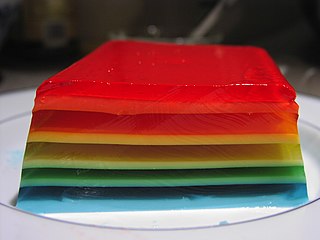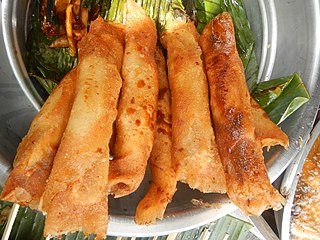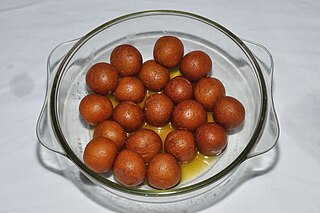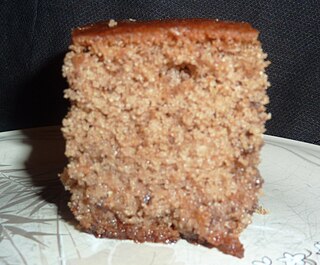Related Research Articles

Dessert is a course that concludes a meal. The course consists of sweet foods, such as confections, and possibly a beverage such as dessert wine and liqueur. In some parts of the world, such as much of Greece and West Africa, and most parts of China, there is no tradition of a dessert course to conclude a meal.

Gelatin desserts are desserts made with a sweetened and flavoured processed collagen product (gelatin). This kind of dessert was first recorded as jelly by Hannah Glasse in her 18th-century book The Art of Cookery, appearing in a layer of trifle. Jelly is also featured in the best selling cookbooks of English food writers Eliza Acton and Isabella Beeton in the 19th century.

Dessert wines, sometimes called pudding wines in the United Kingdom, are sweet wines typically served with dessert.

Porridge is a food made by heating or boiling ground, crushed or chopped starchy plants, typically grain, in milk or water. It is often cooked or served with added flavourings such as sugar, honey, (dried) fruit or syrup to make a sweet cereal, or it can be mixed with spices, meat or vegetables to make a savoury dish. It is usually served hot in a bowl, depending on its consistency. Oat porridge, or oatmeal, is one of the most common types of porridge. Gruel is a thinner version of porridge.

Finnish cuisine is notable for generally combining traditional country fare and haute cuisine with contemporary continental-style cooking. Fish and meat play a prominent role in traditional Finnish dishes in some parts of the country, while the dishes elsewhere have traditionally included various vegetables and mushrooms. Evacuees from Karelia contributed to foods in other parts of Finland in the aftermath of the Continuation War.

Gelato is the common word in Italian for all kinds of ice cream. In English, it specifically refers to a frozen dessert of Italian origin. Artisanal gelato in Italy generally contains 6%–9% butterfat, which is lower than other styles of frozen dessert. Gelato typically contains 35% air and more flavoring than other kinds of frozen desserts, giving it a density and richness that distinguishes it from other ice creams.

Rice pudding is a dish made from rice mixed with water or milk and other ingredients such as cinnamon, vanilla and raisins.

Quindim is a popular Brazilian baked dessert with Portuguese heritage, made chiefly from sugar, egg yolks and ground coconut. It is a custard and usually presented as an upturned cup with a glistening surface and intensely yellow color. The mixture can also be made in a large ring mold in which case it is called a "quindão" and served in slices.

An ice cream cake is a cake with ice cream as the filling for a swiss roll or a layer cake. A simpler no-bake version can be made by layering different flavors of ice cream in a loaf pan.

Turon (Tagalog pronunciation: [tuˈɾɔn]; also known as lumpiang saging, is a Philippine snack made of thinly sliced bananas, dusted with brown sugar, rolled in a spring roll wrapper and fried till the wrapper is crisp. Turon can also include other fillings. Most commonly jackfruit, but there are also recipes with sweet potato , mango , cheddar cheese and coconut .

Pantua is a local confection from the Indian subcontinent, notable in West Bengal, Eastern India and Bangladesh. It is a traditional Bengali sweet made of deep-fried balls of semolina, chhena, milk, ghee and sugar syrup. Pantuas range in colour from pale brown to nearly black depending on how long they are fried. Rose water, cardamom or other flavourings are sometimes added to the sweet.

Sugarcane or sugar cane is a species of tall, perennial grass that is used for sugar production. The plants are 2–6 m (6–20 ft) tall with stout, jointed, fibrous stalks that are rich in sucrose, which accumulates in the stalk internodes. Sugarcanes belong to the grass family, Poaceae, an economically important flowering plant family that includes maize, wheat, rice, and sorghum, and many forage crops. It is native to the warm temperate and tropical regions of India, Southeast Asia, and New Guinea. Grown in tropical and subtropical regions, sugarcane is the world's largest crop by production quantity, totaling 1.9 billion tonnes in 2020, with Brazil accounting for 40% of the world total. Sugarcane accounts for 79% of sugar produced globally. About 70% of the sugar produced comes from Saccharum officinarum and its hybrids. All sugarcane species can interbreed, and the major commercial cultivars are complex hybrids.

Forage and farm-based foods have long been combined in Fijian cuisine. Although rice, wheat, and tea have all been staples during the colonial era, the native Fijians still eat primarily tubers and coconuts in their diet. Native Americans have farmed higher calorie foods like cassava, taro, and yams for thousands of years. The cuisine of Fiji is renowned for its seafood and various green vegetables, including Ota, a young forest fern that is collected for consumption, and Bele, a plant that resembles spinach and is also known as slippery cabbage.
Phoenicia dessert is a type of Lebanese/Syrian cookie. The dessert was named after the ancient Phoenicians.

Macapuno or coconut sport is a naturally occurring coconut cultivar which has an abnormal development of the endosperm. The result of this abnormal development is a soft translucent jelly-like flesh that fills almost the entire central cavity of coconut seeds, with little to no coconut water. Macapuno was first described scientifically from wild specimens in 1931 by Edwin Copeland. They were cultivated commercially in the Philippines after the development of the "embryo rescue" in vitro culture technology in the 1960s by Emerita V. De Guzman. It has become an important crop in coconut-producing countries and is now widely used in the cuisines of Southeast Asia and the Pacific Islands.

Karydopita is a Greek dessert cake made primarily from walnuts and covered in a sweet syrup. Its name is a compound word which derives from "karýdia" and "pita".

Kānga waru is a type of pudding from New Zealand. The dessert is made from cornmeal made into a dough that's wrapped and steamed. The dessert originates from the Māori people and is closely associated with Māori cuisine.

Avocado and milk in ice is a traditional Filipino dessert or beverage made from avocado in milk and sugar. It is preferably eaten cold. Ice are added, or it is partly frozen before consumption. The milk can also be excluded, mixing avocados directly with sugar. The avocados can also be mashed or puréed, which is usually called avocado milkshake or avocado smoothie. Sliced dessert bananas are sometimes added.
References
- ↑ Mintz, Sidney W. "Time, Sugar, and Sweetness." Food and Culture: A Reader. Eds. Carole Counihan and Penny van Esterik. New York: Routledge, 1997.
- ↑ Lambert, Tim. "A BRIEF HISTORY OF DESSERTS AND PUDDINGS". Local Histories. Retrieved 13 February 2014.